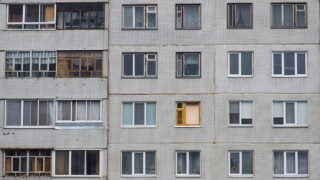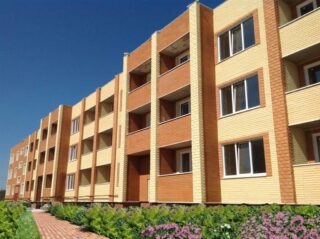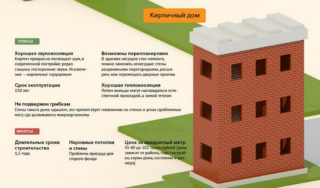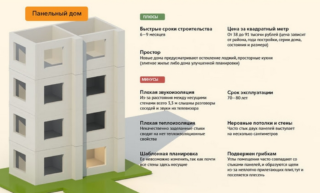The comfort of living in the house is influenced by the material from which the construction was carried out. The level of heat and sound insulation, the possibility of changing the layout, and environmental friendliness depend on it. The most common options are brick, monolithic and panel houses. To determine the optimal housing, it is necessary to compare the pros and cons of all buildings.
House building technology

Potential residents of multi-storey and low-rise new buildings are looking for affordable options, focusing on their own financial capabilities. But this is not the only factor that they have to take into account. In order to objectively assess which house is better: panel, monolithic or brick, you need to find out the features of the technology for their construction.
Panel
The specificity of the method consists in the use of large prefabricated panels in the construction of houses. Initially, they were made of reinforced concrete; in modern conditions, sandwich panels have appeared. This option is warmer and more practical. Panel structures are manufactured separately for external and internal walls and floors. They are single-layer and multi-layer. In the first case, additional thermal insulation is required, in the second version, the insulation is placed between two plates.
When erecting buildings, individual elements are installed on top of each other, and the joints are poured with concrete. In terms of construction speed, panel buildings are three times faster than brick ones, and monolithic ones by 2 times. This makes them popular with developers. Choosing which is better and more reliable: a monolith or a panel house, many people prefer the first option. It is more durable, warmer, apartments have any area. But the price of real estate is also higher.
Brick

Brick houses are a classic in housing construction, but this technology is being replaced by cheaper and faster methods of construction. Masonry requires a lot of material and skilled workers. Ceramic and silicate bricks are used. The weight of one element is 3.6-4.3 kg, so the total mass of the building is enormous. It creates a high load on the foundation, which must be extremely strong. With the advent of slotted and hollow bricks, part of the material is replaced by them. This reduces the weight of the walls and improves thermal insulation.
The monolithic construction method involves the assembly of formwork around a metal frame with floor-by-floor concrete pouring. The buildings are solid and durable, but the work is costly and time consuming.
The advantage of the cast construction is the availability of the layout to your liking, the possibility of combining several apartments on the site or adjacent floors. Also, the building suffers less in the event of a water pipe leak. Another plus is that the construction speed is higher than that of brick buildings. With all the above advantages, in terms of comfort level, monolithic houses are inferior to brick ones.
The main differences between panel and brick houses
Housing is bought for a long time, so it is chosen responsibly, comparing the main criteria of different options.
Life time
The design documentation provides for the estimated service life of buildings. For brick buildings, it is about 150 years, for block buildings - 50 years.Although these are approximate figures and the housing lasts longer, they indicate the established strength of the structures. Block buildings are not designed for an earthquake, they add up when the ground moves. Destruction can be caused not only by seismic activity, but also by an explosion or other emergency.
Comfort
The idea of building prefabricated panel-type buildings appeared in the 50s of the XX century. She did not assume much comfort for people, but gave them a separate living space. Apartments have small combined bathrooms, thin slabs do not protect well from cold in winter and heat in summer. Noise can easily spread through the cracks in floor slabs and wall panels.
In brick houses, the level of comfort is much higher. Walls made of natural material do not heat up in summer, they have the best sound insulation performance among stone buildings. Ceramic brick is vapor-permeable, which allows you to maintain normal humidity in the premises, excludes the appearance of fungus. The architectural form of the facade is not limited to typical projects, unusual solutions are possible. The possibilities for interior planning are also wider than in panel buildings.
The cost
Affordable price is the main argument in favor of choosing a panel type housing. The speed of construction, low labor costs, budget materials - all this reduces the cost of the final cost of square meters. Brick houses belong to the elite segment of real estate. They take years to build and require significant material and labor costs. The cost of apartments is high.
Advantages and disadvantages of houses
All types of housing have pros and cons, comparing them will help determine the right option.
Brick
Advantages:
- Strength and durability - piece products for construction are made in factories by firing clay at a temperature of about 1000 ° C. This makes the material resistant to stress, deformation and moisture. Due to its high density, it can withstand numerous freeze-thaw cycles.
- Creation of a favorable microclimate - the ability to absorb and transfer moisture provides a natural regulation of climatic conditions in the premises.
- Safety - the material is environmentally friendly, fire-resistant, not afraid of biological effects.
- Good heat and sound insulation - the construction of houses is carried out according to the rules, assuming the thickness of the masonry, which provides reliable thermal insulation. The massive construction also copes with cutting off noise.
Disadvantages:
- Long construction period - laboriousness of manual bricklaying and impossibility to mechanize the process is the main problem of the technology. Depending on the number of storeys, the construction time ranges from two years or more.
- The high cost of housing due to objective reasons.
Among the shortcomings, some residents of brick houses call non-compliance with technology during construction. There are voids in the walls due to improper masonry management, theft of materials. Such situations are rare and do not affect the popularity of brick houses.
Due to the slow pace of the construction of buildings, piece products are abandoned in favor of other technologies. Monolithic brick houses are popular, the frame of which is made of reinforced concrete.
Panel
Advantages:
- Construction speed - assembly takes 6 to 12 months. The time depends on the size of the buildings, usually their height does not exceed 12 floors.For small buildings, frame-panel technology is used, high-rise buildings are erected in a frameless way. Confidence in a quick construction allows you to purchase housing at the initial stage of work.
- Minimal costs for interior decoration, the walls of panel structures are fairly flat. They do not require the cost of rough finishing and preparatory work.
- Low cost that attracts people on a budget.
Disadvantages:
- Poor thermal insulation - the joints of the panels are the weak point of the structure. Often they are irresponsible in sealing them, so residents are faced with drafts and heat escape through the cracks. Moisture seeps through the joints, causing mold in the corners. The thickness of single-layer boards is also insufficient to maintain a comfortable temperature. To improve the situation, it is necessary to carry out external wall insulation.
- Low sound insulation is the main problem of buildings, people hear noise from all neighbors. Thin concrete panels are not able to stop the propagation of acoustic noise. Installing soundproofing materials helps to improve the situation.
- It is impossible to redevelop the premises, since the walls are load-bearing, they cannot be destroyed. Difficulties also arise when chipping walls for wiring and installing sockets. Concrete is difficult to break and the work is time-consuming and labor-intensive.
In new panel-type buildings, the disadvantages of buildings of previous years are taken into account. Various facade solutions have appeared, and the internal layout has improved. Modern heaters in multi-layer panels provide better protection from cold and noise.
Which house is better: panel or brick

Numerous Internet users in their reviews unequivocally agree that the brick type is preferable. Their choice is explained by the advantages of building from piece material:
- the difference in the service life of the houses is 100 years;
- sound insulation at a sufficient level;
- enclosing structures provide high-quality thermal insulation and a normal microclimate;
- different layouts are possible;
- lack of mold and dampness.
The main difference between a panel house and a brick house is an insufficient level of comfort. This is a practical option that requires additional costs in order to provide high-quality insulation and improve sound insulation. Despite the listed disadvantages, panel houses are more popular with developers and buyers. The reason is the high profitability of construction and the affordable cost of apartments.











The person who wrote this apparently does not assume how structures behave during an earthquake. The safest place in case of a strong earthquake is considered to be the upper floors of the outer entrances (attention !!!!) of panel houses. A brick house turns into dust, it is impossible to survive in it, the panel folding leaves voids in which you can survive. In terms of the quality of construction, I will say this, if the developer wants to cash in on you, then you will get brick cold shit with mold, lack of sound insulation and other shortcomings. It all depends not on the type of house, but on the greed and professionalism of the builders. I have been living in the socket for 5 years already, I go barefoot in shorts in winter. Before that he lived in a brick house, it was cold to the point of tin, the street wall froze through. no need to compare the buildings of the 60-70s made of bricks that were produced in the USSR with wall thicknesses of 80-90 cm and modern new buildings sheathed with polystyrene and built of Chinese shit called "brick"
You will live in your panel house for another 10 years, put on woolen socks.
I live in a pre-perestroika panel, with an experimental layout for those times. We turn off the batteries in winter, some parking lots are heated and neighbors are not heard from the word at all. Children in a new brick house insulated the outer wall and neighbors were very audible. And we had to fight mold in the window openings.I will not change my socket on a new building with problems
Yes, the buildings of the 70s are no better, I lived in a brick, the audibility is horror, it turned out to be emptiness in the walls, thieves are always dragging, the warmth is also relative, cold batteries, so there is no heat ....